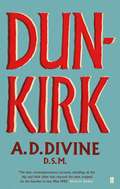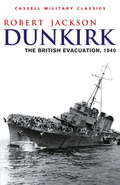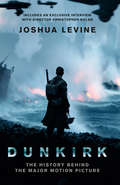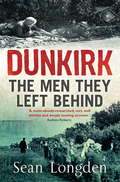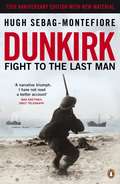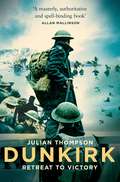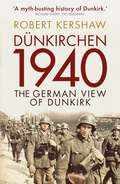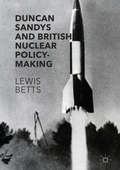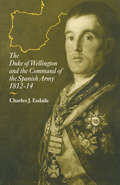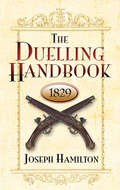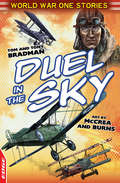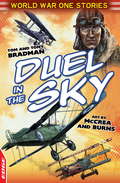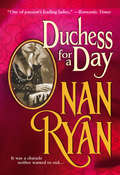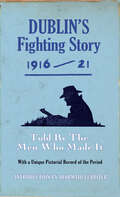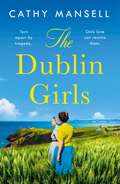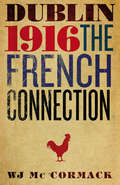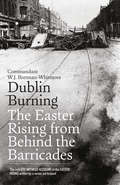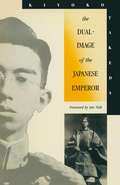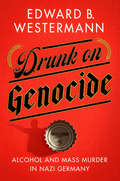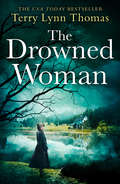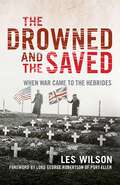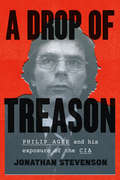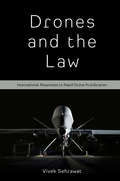- Table View
- List View
Dunkirk
by A.D. Divine O.B.E.This is the story of Dunkirk and of the men who planned it (insofar as it was planned) and of the men who carried it out, and of their ships. Mr Divine, who was himself with the small boats, writes with the authority of direct knowledge. He had the assistance of the men who were intimately concerned with planning and organising the operation. This is the true story of Dunkirk from its almost nebulous beginnings to the astonishing triumph of its end.
Dunkirk: The British Evacuation, 1940 (Sven Hassel War Classics)
by Robert JacksonA gripping account of the most famous military defeat and retreat in history, now the subject of a major motion picture, written and directed by Christopher Nolan and starring Kenneth Branagh, Tom Hardy and Mark Rylance.The NEW YORK TIMES of 2 June 1940 summed up the greatest disaster in British history thus: 'As long as the English tongue survives, the word 'Dunkirk' will be spoken with reverence.'This book tells the story of the Dunkirk evacuation. It traces the fortunes of the British Expeditionary Force during those dark days of May 1940 when boys armed with little more than rifles took on the might of Hitler's Panzer divisions - and held them while Allied armies crumbled on all sides. The evacuation at Dunkirk lifted more than 338,000 men from France to the safety of Britain using everything from Destroyers to pleasure yachts. It was the biggest single defeat ever suffered by British arms, but it was also one of the most astounding exoduses in history.
Dunkirk: The History Behind The Major Motion Picture
by Joshua LevineTHE NUMBER ONE SUNDAY TIMES BESTSELLER THE EPIC TRUE STORY OF DUNKIRK – NOW A MAJOR MOTION PICTURE, WRITTEN AND DIRECTED BY CHRISTOPHER NOLAN AND STARRING KENNETH BRANAGH, TOM HARDY AND MARK RYLANCE.
Dunkirk: The Men They Left Behind
by Sean LongdenTHE TRUE STORY OF THE 41,000 BRITISH SOLDIERS WHO WERE LEFT BEHIND AFTER THE EVACUATION OF DUNKIRK, MAY 1940'Meticulously researched, very well written and deeply moving' Andrew Roberts'Few readers will be unmoved by Sean Longden's account' Dominic SandbrookAt 2am on the morning of the 3rd of June 1940, General Harold Alexander searched along the quayside, holding onto his megaphone and called "Is anyone there? Is anyone there?" before turning his boat back towards England. Tradition tells us that the dramatic events of the evacuation of Dunkirk, in which 300,000 BEF servicemen escaped the Nazis, was a victory gained from the jaws of defeat. For the first time, rather than telling the tale of the 300,000 who escaped, Sean Longden reveals the story of the 40,000 men sacrificed in the rearguard battles.On the beaches and sand dunes, besides the roads and amidst the ruins lay the corpses of hundreds who had not reached the boats. Elsewhere, hospitals full of the sick and wounded who had been left behind to receive treatment from the enemy's doctors. And further afield - still fighting hard alongside their French allies - was the entire 51st Highland Division, whose war had not finished as the last boats slipped away. Also scattered across the countryside were hundreds of lost and lonely soldiers. These 'evaders' had also missed the boats and were now desperately trying to make their own way home, either by walking across France or rowing across the channel. The majority, however, were now prisoners of war who were forced to walk on the death marches all the way to the camps in Germany and Poland, where they were forgotten until 1945.'Sean Longden is a rising name in military history, and is able to uncover the missing stories of the Second World War' Guardian
Dunkirk: Fight to the Last Man
by Hugh Sebag-Montefiore* * * Special 75th Anniversary Edition * * * Hugh Sebag-Montefiore's Dunkirk: Fight to the Last Man tells the story of the rescue in May 1940 of British soldiers fleeing capture and defeat by the Nazis at Dunkirk.Dunkirk was not just about what happened at sea and on the beaches. The evacuation would never have succeeded had it not been for the tenacity of the British soldiers who stayed behind to ensure they got away. Men like Sergeant Major Gus Jennings who died smothering a German stick bomb in the church at Esquelbecq in an effort to save his comrades, and Captain Marcus Ervine-Andrews VC who single-handedly held back a German attack on the Dunkirk perimeter thereby allowing the British line to form up behind him. Told to stand and fight to the last man, these brave few battalions fought in whatever manner they could to buy precious time for the evacuation. Outnumbered and outgunned, they launched spectacular and heroic attacks time and again, despite ferocious fighting and the knowledge that for many only capture or death would end their struggle.'A searing story . . . both meticulous military history and a deeply moving testimony to the extraordinary personal bravery of individual soldiers' Tim Gardam, The Times 'Sebag-Montefiore tells [the story] with gusto, a remarkable attention to detail and an inexhaustible appetite for tracking down the evidence' Richard Ovary, Telegraph Hugh Sebag-Montefiore was a barrister before becoming a journalist and then an author. He wrote the best-selling Enigma: The Battle for the Code. One of his ancestors was evacuated from Dunkirk.
Dunkirk: Retreat to Victory
by Julian ThompsonA masterly work of military history, Dunkirk: Retreat to Victory is also a tribute to the soldiers whose courage and self belief sustained them through their darkest hours.The evacuation of British forces from Dunkirk is one of the pivotal moments in the Second World War – an astonishing endeavour that snatched victory from the jaws of defeat. Sent to help the Belgians and French hold back the German army, the small British Expeditionary Force was ill-equipped and under-trained. When Hitler attacked on 10 May 1940 and the French and Belgian armies collapsed in the face of Germany's swift and brutal advance, the British soldiers found themselves in mortal danger.In Dunkirk: Retreat to Victory, Major General Julian Thompson recreates the action as the British fought hard for three desperate weeks, conducting a successful fighting withdrawal in the face of a formidable foe. He describes the individual acts of bravery and sacrifice and analyses the decisions of the commanders who made the choice to evacuate. He also takes us to Dunkirk harbour and onto the beaches, where the British army was trapped and under attack, while the Royal Navy and the 'little ships' raced against time to rescue them.
Dünkirchen 1940: The German View of Dunkirk
by Robert KershawUsing revelatory new material on an event which changed the tide of World War II, Robert Kershaw's ground-breaking history explores the Battle of Dunkirk from the German perspective.'Military history of the highest order.' Jonathan Dimbleby, author and broadcaster The British evacuation from the beaches of the small French port town of Dunkirk is one of the iconic moments of military history. The battle has captured the popular imagination through LIFE magazine photo spreads, the fiction of Ian McEwan and, of course, Christopher Nolan's hugely successful Hollywood blockbuster. But what is the German view of this stunning Allied escape? Drawing on German interviews, diaries and unit post-action reports, Robert Kershaw creates a page-turning history of a battle that we thought we knew. Dünkirchen 1940 is the first major history on what went wrong for the Germans at Dunkirk. As supreme military commander, Hitler had seemingly achieved a miracle after the swift capitulation of Holland and Belgium, but with just seven kilometres before the panzers captured Dunkirk – the only port through which the trapped British Expeditionary force might escape – they came to a shuddering stop. Hitler had lost control of his stunning advance. Only a detailed interpretation of the German perspective – historically lacking to date – can provide answers as to why. Drawing on his own military experience, his German language skills and his historian's eye for detail, Robert Kershaw creates a new history of this familiar battle. With a fresh angle on this famous conflict, Dünkirchen 1940 delves into the under-evaluated major German miscalculation both strategically and tactically that arguably cost Hitler the war.
Dünkirchen 1940: The German View of Dunkirk
by Robert KershawUsing revelatory new material on an event which changed the tide of World War II, Robert Kershaw's ground-breaking history explores the Battle of Dunkirk from the German perspective.'Military history of the highest order.' Jonathan Dimbleby, author and broadcaster The British evacuation from the beaches of the small French port town of Dunkirk is one of the iconic moments of military history. The battle has captured the popular imagination through LIFE magazine photo spreads, the fiction of Ian McEwan and, of course, Christopher Nolan's hugely successful Hollywood blockbuster. But what is the German view of this stunning Allied escape? Drawing on German interviews, diaries and unit post-action reports, Robert Kershaw creates a page-turning history of a battle that we thought we knew. Dünkirchen 1940 is the first major history on what went wrong for the Germans at Dunkirk. As supreme military commander, Hitler had seemingly achieved a miracle after the swift capitulation of Holland and Belgium, but with just seven kilometres before the panzers captured Dunkirk – the only port through which the trapped British Expeditionary force might escape – they came to a shuddering stop. Hitler had lost control of his stunning advance. Only a detailed interpretation of the German perspective – historically lacking to date – can provide answers as to why. Drawing on his own military experience, his German language skills and his historian's eye for detail, Robert Kershaw creates a new history of this familiar battle. With a fresh angle on this famous conflict, Dünkirchen 1940 delves into the under-evaluated major German miscalculation both strategically and tactically that arguably cost Hitler the war.
Duncan Sandys and British Nuclear Policy-Making
by Lewis BettsThis book offers new perspectives on British nuclear policy-making at the height of the Cold War, arguing that the decisions taken by the British government during the 1950s and 1960s in pursuit of its nuclear ambitions cannot be properly understood without close reference to Duncan Sandys, and in particular the policy preferences that emerged from his experiences of the Second World War and his efforts leading Britain's campaign against the V-1 and V-2. Immersing himself in this campaign against unmanned weaponry, Sandys came to see ballistic missiles as the only guarantor of nuclear credibility in the post-war world, placing them at the centre of his strategic thinking and developing a sincerely-held and logically-consistent belief system which he carried with him through a succession of ministerial roles, allowing him to exert a previously undocumented level of influence on the nature of Britain's nuclear capabilities and its approach to the Cold War. This book shows the profound influence Sandys' personal belief system had on Britain's attempts to acquire a credible nuclear deterrent.
The Duelling Handbook, 1829
by Joseph HamiltonProfoundly embedded in our cultural consciousness, the art of duelling evokes images of a dramatic past, where the laws of courtesy, civility, and honor were enforced by the end of a rapier at the first rays of dawn. In this engrossing historical record of the codes and conduct of the duel — originally written in 1829 as "The Only Approved Guide Through All the Stages of a Quarrel" — every aspect of the arcane practice is brought to fascinating light.Offering authentic advice on such subjects as withdrawal of challenges, weapons, distance, and the fate of survivors, The Duelling Handbook also brims with vivid anecdotes recounting duels between brothers, duels between friends, and those arising from disagreements over religion, women, gambling, and other volatile standpoints. A genuine historical treasure, Hamilton's unequaled guidebook will captivate — and enlighten — a wide audience of readers, especially those intrigued by the moral and sociological issues surrounding the art of the duel.
Duel In The Sky: World War One Short Stories: Duel In The Sky (EDGE: World War One Short Stories #1)
by Tony BradmanA new German fighter ace is terrorising British planes over the trenches of France. It will take the bravery and sacrifice of a Britsh ace and the courage of a hero to bring him down.This title is published by Franklin Watts EDGE, which produces a range of books to get children reading with confidence. EDGE - for books kids can't put down.
Duel In The Sky: World War One Short Stories: Duel In The Sky (EDGE: World War One Short Stories)
by Tony BradmanA new German fighter ace is terrorising British planes over the trenches of France. It will take the bravery and sacrifice of a Britsh ace and the courage of a hero to bring him down.This title is published by Franklin Watts EDGE, which produces a range of books to get children reading with confidence. EDGE - for books kids can't put down.
Dublin's Fighting Story 1916 - 21: Told By The Men Who Made It (The Fighting Stories)
by The KerrymanMajor Haig ordered them to 'prepare to fire', whereupon they the fired indiscriminately, point blank, at the people in the street. Four people were killed and thirty-seven wounded. All Ireland seethed with indignation . . . '&newpara;This new edition of Dublin's Fighting Story with an introduction by Diarmaid Ferriter features stories and reports from every aspect of the War of Independence, from the formation of the Fianna Éireann and the Volunteers, through the Great Dublin Strike and Lock-out in 1913 and the 1916 Rising to the death of Seán Treacy in a bloody street shoot-out, the triumph and tragedy of Bloody Sunday and the burning of the Customs House. Dublin's Fighting Story offers the perspective of the eye witnesses and fighting men themselves to the struggle for independence in Dublin.
The Dublin Girls: A powerfully heartrending family saga
by Cathy MansellDramatic, emotional and romantic, if you love Lorna Cook, Tracy Rees and Jenny Ashcroft, you'll love this gripping and heartrending novel from Cathy Mansell, author of A Place to Belong.In 1950s Dublin, life is hard and jobs are like gold dust.Nineteen-year-old Nell Flynn is training to be a nurse and planning to marry her boyfriend, Liam Connor, when her mother dies, leaving her younger sisters destitute. To save them from the workhouse, Nell returns to the family home - a mere two rooms at the top of a condemned tenement.Nell finds work at a biscuit factory and, at first, they scrape through each week. But then eight-year-old Róisín, delicate from birth, is admitted to hospital with rheumatic fever and fifteen-year-old Kate, rebellious, headstrong and resentful of Nell taking her mother's place, runs away.When Liam finds work in London, Nell stays to struggle on alone - her unwavering devotion to her sisters stronger even than her love for him. She's determined that one day the Dublin girls will be reunited and only then will she be free to follow her heart.Look for more gripping, heartwrenching page-turners from Cathy Mansell - don't miss A Place to Belong, out now.
Dublin Easter 1916 The French Connection: The French Connection (Studies In Violence, Mimesis And Culture Ser.)
by Bill Mc CormackAll revolutionary movements since 1789 have looked instinctively to the French model. In this book, Bill Mc Cormack demonstrates that the French influence in Ireland was indeed profound, especially in the years leading up to the Easter Rising.However, it was not the traditions of the Tennis Court Oath or Bastille Day that motivated the Irish rebels, but a new French Catholic nationalism which reached its apogee with the Dreyfus Affair (1895) and which pervaded literature as well as politics.This was a complex reactionary movement, partly religiose, partly royalist, and anti-modern. In Ireland, its influence was advanced through the thought of individual visitors, through Catholic teaching orders, and through a vigorous periodical press. The 'blood sacrifice' rhetoric of Patrick Pearse and (eventually) James Connolly owes more to Maurice Barres than to Wolfe Tone. Connolly's use of the sympathetic strike derives from Georges Sorel's syndicalism.Mc Cormack examines how the formerly anti-clerical Irish Republican Brotherhood was in effect re-baptised by a French-inspired Catholic mission, which even absorbed Pearse's English and agnostic father. He explores the wealth of French material published by Thomas MacDonagh and J. M. Plunkett in The Irish Review (1911-1914), and traces the long campaign of The Catholic Bulletin to convert the rebel dead into martyrs. Finally, he discusses how the anti-democratic undertow of 1916 breaks out again in 1939 with the IRA's bombing campaign in England.
Dublin Burning: The Only Eye-Witness Account of the Easter Rising written by a senior participant
by W.J. Brennan-WhitmoreDublin Burning is a vivid, clear-eyed account of the 1916 Rising and is the most complete account we have from a senior participant. No other senior Volunteer figure has left a similar memoir of Easter Week.Commandant W.J. Brennan-Whitmore was officer commanding the Volunteer position at the head of North Earl Street, an outworking of the GPO garrison. Its purpose was to delay and frustrate any attempt by the British to deploy reinforcements coming from Amiens Street railway station (now Connolly).Commandant Brennan-Whitmore and his men held this position for over seventy-two hours until forced out by British artillery. He and his troops attempted to retreat northwards through the slums, hoping to reach the safety of the suburbs. But he and his men were not Dubliners and were unfamiliar with the city. They were captured in a tenement where they had taken refuge and were interned in Frongoch in Wales until 1917.Brennan-Whitmore’s book is a unique document, one of the most valuable accounts of the Rising available to us.
The Dual-Image of the Japanese Emperor
by Kiyoko TakedaAt the end of World War II and through the Allied occupation, the Allies deliberated whether to abolish or to preserve the Japanese Emperor system. This is a study of the transformation of Japan under the impact of the democratizing policy of a forceful military occupation from the West.
Drunk on Genocide: Alcohol and Mass Murder in Nazi Germany (Battlegrounds: Cornell Studies in Military History)
by Edward B. WestermannIn Drunk on Genocide, Edward B. Westermann reveals how, over the course of the Third Reich, scenes involving alcohol consumption and revelry among the SS and police became a routine part of rituals of humiliation in the camps, ghettos, and killing fields of Eastern Europe. Westermann draws on a vast range of newly unearthed material to explore how alcohol consumption served as a literal and metaphorical lubricant for mass murder. It facilitated "performative masculinity," expressly linked to physical or sexual violence. Such inebriated exhibitions extended from meetings of top Nazi officials to the rank and file, celebrating at the grave sites of their victims. Westermann argues that, contrary to the common misconception of the SS and police as stone-cold killers, they were, in fact, intoxicated with the act of murder itself. Drunk on Genocide highlights the intersections of masculinity, drinking ritual, sexual violence, and mass murder to expose the role of alcohol and celebratory ritual in the Nazi genocide of European Jews. Its surprising and disturbing findings offer a new perspective on the mindset, motivation, and mentality of killers as they prepared for, and participated in, mass extermination.Published in Association with the US Holocaust Memorial Museum.
The Drowned Woman (The Sarah Bennett Mysteries #3)
by Terry Lynn ThomasFamily secrets won’t always stay buried…
The Drowned and the Saved: – Saltire Society History Book of The Year 2018
by Les Wilson'Next morning at about 6 o’clock my mother wakened us to say there had been a shipwreck and bodies were being washed ashore. My father had gone with others to look for survivors ... I don’t think any survivors came in at Port Ellen but bodies did.'The loss of two British ships crammed with American soldiers bound for the trenches of the First World War brought the devastation of war directly to the shores of the Scottish island of Islay.The sinking of the troopship Tuscania by a German U-Boat on 5 February 1918 was the first major loss of US troops in in the war. Eight months after the people of Islay had buried more than 200 Tuscania dead, the armed merchant cruiser Otranto collided with another troopship during a terrible storm. Despite a valiant rescue attempt by HMS Mounsay, the Otranto drifted towards Islay, hit a reef, throwing 600 men into the water. Just 19 survived; the rest were drowned or crushed by the wreckage.Based on the harrowing personal recollection of survivors and rescuers, newspaper reports and original research, Les Wilson tells the story of these terrible events, painting a vivid picture which also pays tribute to the astonishing bravery of the islanders, who risked their lives pulling men from the sea, caring for survivors and burying the dead.
A Drop of Treason: Philip Agee and His Exposure of the CIA
by Jonathan StevensonPhilip Agee’s story is the stuff of a John le Carré novel—perilous and thrilling adventures around the globe. He joined the CIA as a young idealist, becoming an operations officer in hopes of seeing the world and safeguarding his country. He was the consummate intelligence insider, thoroughly entrenched in the shadow world. But in 1975, he became the first such person to publicly betray the CIA—a pariah whose like was not seen again until Edward Snowden. For almost forty years in exile, he was a thorn in the side of his country. The first biography of this contentious, legendary man, Jonathan Stevenson’s A Drop of Treason is a thorough portrait of Agee and his place in the history of American foreign policy and the intelligence community during the Cold War and beyond. Unlike mere whistleblowers, Agee exposed American spies by publicly blowing their covers. And he didn’t stop there—his was a lifelong political struggle that firmly allied him with the social movements of the global left and against the American project itself from the early 1970s on. Stevenson examines Agee’s decision to turn, how he sustained it, and how his actions intersected with world events. Having made profound betrayals and questionable decisions, Agee lived a rollicking, existentially fraught life filled with risk. He traveled the world, enlisted Gabriel García Márquez in his cause, married a ballerina, and fought for what he believed was right. Raised a conservative Jesuit in Tampa, he died a socialist expat in Havana. In A Drop of Treason, Stevenson reveals what made Agee tick—and what made him run.
A Drop of Treason: Philip Agee and His Exposure of the CIA
by Jonathan StevensonPhilip Agee’s story is the stuff of a John le Carré novel—perilous and thrilling adventures around the globe. He joined the CIA as a young idealist, becoming an operations officer in hopes of seeing the world and safeguarding his country. He was the consummate intelligence insider, thoroughly entrenched in the shadow world. But in 1975, he became the first such person to publicly betray the CIA—a pariah whose like was not seen again until Edward Snowden. For almost forty years in exile, he was a thorn in the side of his country. The first biography of this contentious, legendary man, Jonathan Stevenson’s A Drop of Treason is a thorough portrait of Agee and his place in the history of American foreign policy and the intelligence community during the Cold War and beyond. Unlike mere whistleblowers, Agee exposed American spies by publicly blowing their covers. And he didn’t stop there—his was a lifelong political struggle that firmly allied him with the social movements of the global left and against the American project itself from the early 1970s on. Stevenson examines Agee’s decision to turn, how he sustained it, and how his actions intersected with world events. Having made profound betrayals and questionable decisions, Agee lived a rollicking, existentially fraught life filled with risk. He traveled the world, enlisted Gabriel García Márquez in his cause, married a ballerina, and fought for what he believed was right. Raised a conservative Jesuit in Tampa, he died a socialist expat in Havana. In A Drop of Treason, Stevenson reveals what made Agee tick—and what made him run.
Drones and the Law: International Responses to Rapid Drone Proliferation
by Dr Vivek SehrawatThe growing ubiquity of drones means that they are more readily available for both terrorists and civilians to use. At the same time, the military use of drones has globalised. Yet regulations for their international use, both military and domestic, are sparse and lacking in clarity, and most books on the legality of drones tend to be written by journalists or activists. Drones and the Law: International Responses to Rapid Drone Proliferation presents a fresh, scholarly perspective on the increasingly complex relations between drone usage and international and privacy law. Combining expert insights into strategy, international law, international humanitarian law, targeted killing, ethics, and privacy, Vivek Sehrawat offers an important historical and context for understanding how drone usage has become widespread; investigates how international law and international humanitarian law on the use of force interact with the rapid proliferation of military drones; and outlines how civilian use of drones poses specific challenges to national privacy laws in large countries such as the UK, the USA, and India. Throughout, Sehrawat discusses potential world policies for drone strikes and counter terrorism and debunks myths about current drone capabilities and the law regarding drone usage, making this book a useful and timely addition to the growing literature on drones and the law. For its rigorous legal research that offers a precise, accurate, and authoritative account of the legal challenges posed by rapid drone proliferation, Drones and the Law is a must-read for students and scholars of law and international relations.
